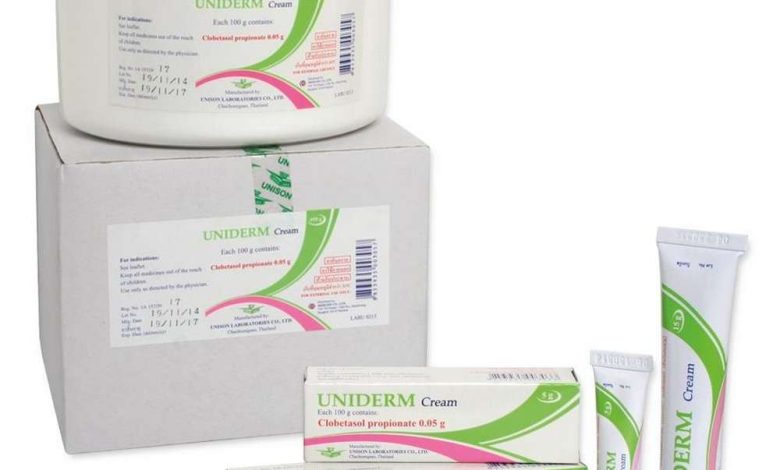Uniderm: instructions for using the medicine, structure, Contraindications

Active material: Mometazon
When ATH: D07AC13
CCF: SCS for external use
ICD-10 codes (testimony): L20.8, L23, L24, L28.0, L29
When CSF: 04.05
Manufacturer: Chemical-Pharmaceutical Plant JSC QUINACRINE (Russia)
Uniderm: dosage form, composition and packaging
Cream for external application 0.1% white or nearly white.
| 1 g | |
| mometasone furoate | 1 mg |
Excipients: hexylene, glyceryl monostearate 40-55, cetostearyl alcohol, macrogol 20 cetilstearat, white wax, Titanium dioxide, aluminum starch octenyl succinate, phosphoric acid diluted, white petrolatum, Purified water.
15 g – aluminum tuba (1) – packs cardboard.
30 g – aluminum tuba (1) – packs cardboard.
Uniderm: pharmachologic effect
SCS for external use. It has anti-inflammatory, antipruritic, antiexudativ action.
Mometazon (Like other corticosteroids) induces the selection of proteins, inhibiting phospholipase A2 and collectively known lipocortin, which control the biosynthesis of inflammatory mediators, as the prostaglandins and leukotrienes, by inhibiting the release of their common precursor, arachidonic acid.
Uniderm: pharmacokinetics
When applied topically Uniderm cream® absorption is negligible. Through 8 hours after application to intact skin (without occlusive dressing) in the systemic circulation detected near 0.4% active substance.
Uniderm: testimony
- inflammatory symptoms and itching in dermatoses, measurable GCS.
Uniderm: dosing regimen
The drug is used topically.
A thin layer of cream Uniderm® is applied to the affected skin 1 time / day. The duration of treatment is determined by its efficiency, and patient tolerance, presence and severity of side effects
Uniderm: side effects
Dermatological reactions: rarely – irritation and dryness of the skin, burning sensation, itch, folliculitis, hypertryhoz, acne, gipopigmentatsiya, perioral dermatitis, maceration of the skin, the accession of secondary infection, signs of skin atrophy, striae, jerseys; < 1% – papulation, pustules.
Allergic reactions: contact type allergy.
Other: when applying cream Uniderm® for a long time and / or to treat large areas of skin, or using occlusive dressings, especially in children and adolescents, Side effects may occur, characteristic systemic corticosteroids, including adrenal insufficiency and Cushing's syndrome.
Uniderm: Contraindications
- rosacea;
- perioral dermatitis;
- Bacterial, Viral (caused by the Herpes simplex types 1 and 2, Varicella zoster ) or fungal infections of the skin;
- tuberculosis;
- syphilis;
- post-vaccination reactions;
- Children up to age 6 months;
- pregnancy (treatment of large areas of skin, long-term treatment);
- lactation (used in high doses and / or for a long time);
- hypersensitivity to the drug.
FROM caution the drug should be used on the face and in skin folds, with occlusive dressing, and when applied to large areas of skin and / or long-term care (especially in children older 6 months).
Uniderm: Pregnancy and lactation
Security applications Uniderm cream® during pregnancy and lactation has not been studied.
GCS cross the placental barrier. If pregnancy should avoid prolonged treatment and use of the drug in high doses because of the threat of negative impact on fetal development.
Corticosteroids are excreted in breast milk. When, when it is intended to use the drug in high doses and / or for a long time, should stop breastfeeding.
Uniderm: Special instructions
When applied to large areas of the skin for a long time, especially when using occlusive dressings, may develop systemic corticosteroids. Considering this, should monitor the condition of patients to identify the function of suppressing the symptoms of the hypothalamic-pituitary-adrenal system and the development of Cushing's syndrome.
Avoid getting the cream Uniderm® in the eyes.
propylene glycol, part of the drug, may cause irritation at the site of application. In such cases, discontinue using the cream Uniderm® and appropriate treatment.
It should be taken into account, that corticosteroids are able to change some of the manifestations of skin diseases, which may hinder diagnosis. Besides, application of corticosteroids may cause a delay of wound healing.
When long-term therapy of GCS sudden cessation of treatment can lead to rebound syndrome, manifests itself in the form of dermatitis with intense redness and burning sensation. Therefore, after the long course of treatment drug cancellation Uniderm® It should be carried out gradually, eg, switching to intermittent treatment regimen before, how to completely stop.
Use in Pediatrics
The safety and efficacy Uniderm cream® when applied topically in children older 6 months during the period, exceeding 6 weeks, We have not been studied.
Because, that in children the value of the surface area ratio and body mass over, than in adults, Children are at greater risk of suppression of the hypothalamic-pituitary-adrenal system and the development of Cushing's syndrome in the application of any corticosteroids for external and local application.
Long-term treatment in older children 6 months should be undertaken with caution. Long-term treatment of children corticosteroids may impair their growth and development. Children should receive the lowest dose of the drug, sufficient to achieve the effect. Children between the ages of 6 months before 2 years treatment should not exceed 5 days.
Uniderm: overdose
Symptoms: suppression of the hypothalamic-pituitary-adrenal axis, including secondary adrenal insufficiency.
Treatment: symptomatic, if necessary – correction of electrolyte imbalance, removal of the drug (long-term therapy – phasing-out).
Uniderm: drug interaction
–
Uniderm: terms of dispensing from pharmacies
The drug is released under the prescription.
Uniderm: terms and conditions of storage
List B. The drug should be stored out of reach of children at temperature from 15 ° to 25 ° C. Shelf life – 2 year.
